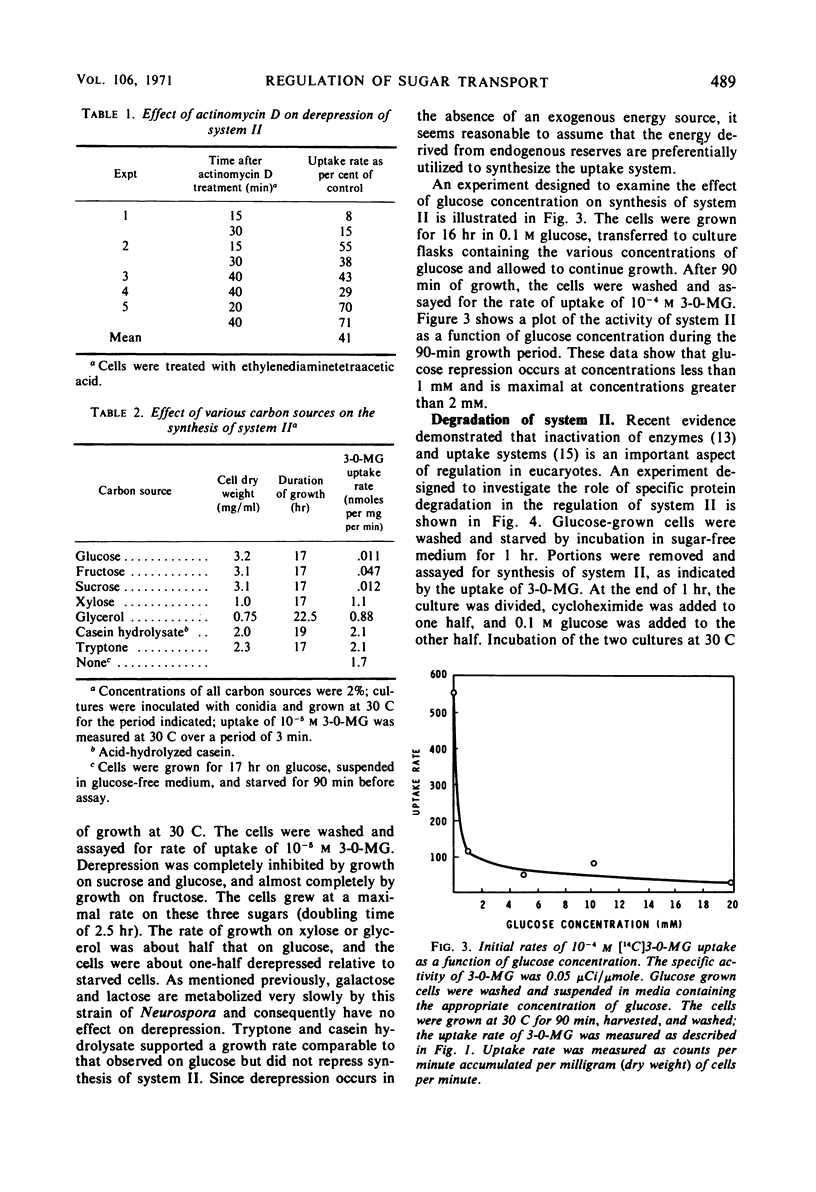Abstract
Sugar uptake systems in Neurospora crassa are catabolically repressed by glucose. Synthesis of a low Km glucose uptake system (system II) in Neurospora is derepressed during starvation for an externally supplied source of carbon and energy. Fasting also results in the derepression of uptake systems for fructose, galactose, and lactose. In contrast to the repression observed when cells were grown on glucose, sucrose, or fructose, system II was not repressed by growth on tryptone and casein hydrolysate. System II was inactivated in the presence of 0.1 m glucose and glucose plus cycloheximide but not by cycloheximide alone. Inactivation followed first-order kinetics with a half-time of 40 min. The addition of glycerol to the uptake medium had no significant effect on the kinetics of 3-0-methyl glucose uptake, suggesting that the system was not feedback inhibitable by catabolites of glycerol metabolism.
Full text
PDF





Selected References
These references are in PubMed. This may not be the complete list of references from this article.
- HOFFEE P., ENGLESBERG E. Effect of metabolic activity on the glucose permease of bacterial cells. Proc Natl Acad Sci U S A. 1962 Oct 15;48:1759–1765. doi: 10.1073/pnas.48.10.1759. [DOI] [PMC free article] [PubMed] [Google Scholar]
- Kaback H. R. Regulation of sugar transport in isolated bacterial membrane preparations from Escherichia coli. Proc Natl Acad Sci U S A. 1969 Jul;63(3):724–731. doi: 10.1073/pnas.63.3.724. [DOI] [PMC free article] [PubMed] [Google Scholar]
- Klingmüller W. Aktive Aufnahme von Zuckern durch Zellen von Neurospora crassa unter Beteiligung eines enzymatischen Systems mit Permeaseeigenschaften I. Z Naturforsch B. 1967 Feb;22(2):181–188. [PubMed] [Google Scholar]
- LESTER G., AZZENA D., HECHTER O. Permeability and metabolism of lactose in Neurospora crassa. J Bacteriol. 1962 Aug;84:217–227. doi: 10.1128/jb.84.2.217-227.1962. [DOI] [PMC free article] [PubMed] [Google Scholar]
- Morgan M. J., Kornberg H. L. Regulation of sugar accumulation by Escherichia coli. FEBS Lett. 1969 Apr;3(1):53–56. doi: 10.1016/0014-5793(69)80095-5. [DOI] [PubMed] [Google Scholar]
- ROBERTSON J. J., HALVORSON H. O. The components of maltozymase in yeast, and their behavior during deadaptation. J Bacteriol. 1957 Feb;73(2):186–198. doi: 10.1128/jb.73.2.186-198.1957. [DOI] [PMC free article] [PubMed] [Google Scholar]
- Scarborough G. A. Sugar transport in Neurospora crassa. II. A second glucose transport system. J Biol Chem. 1970 Aug 10;245(15):3985–3987. [PubMed] [Google Scholar]
- Scarborough G. A. Sugar transport in Neurospora crassa. J Biol Chem. 1970 Apr 10;245(7):1694–1698. [PubMed] [Google Scholar]
- Schneider R. P., Wiley W. R. Kinetic characteristics of the two glucose transport systems in Neurospora crassa. J Bacteriol. 1971 May;106(2):479–486. doi: 10.1128/jb.106.2.479-486.1971. [DOI] [PMC free article] [PubMed] [Google Scholar]
- Tomkins G. M., Gelehrter T. D., Granner D., Martin D., Jr, Samuels H. H., Thompson E. B. Control of specific gene expression in higher organisms. Expression of mammalian genes may be controlled by repressors acting on the translation of messenger RNA. Science. 1969 Dec 19;166(3912):1474–1480. doi: 10.1126/science.166.3912.1474. [DOI] [PubMed] [Google Scholar]
- Turner J. R., Terry K., Matchett W. H. Temporal separation of transcription and translation in Neurospora. J Bacteriol. 1970 Aug;103(2):370–374. doi: 10.1128/jb.103.2.370-374.1970. [DOI] [PMC free article] [PubMed] [Google Scholar]
- Wiley W. R., Matchett W. H. Tryptophan transport in Neurospora crassa. II. Metabolic control. J Bacteriol. 1968 Mar;95(3):959–966. doi: 10.1128/jb.95.3.959-966.1968. [DOI] [PMC free article] [PubMed] [Google Scholar]


